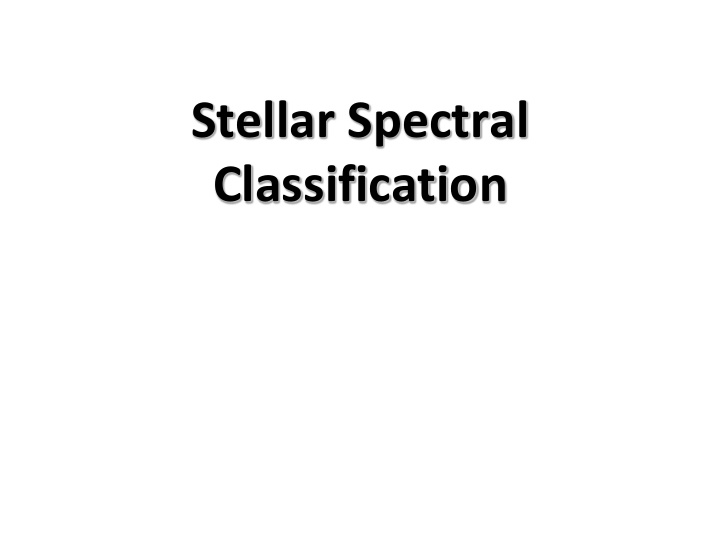



Stellar Spectral Classification
Literature The bible : „ Stellar Spectral Classification “, R.O. Gray, C. J. Corbally, 2009, Princeton Series in Astrophysics Older, but a good overview : „ The Classification of Stars “, C. Jaschek & M. Jaschek, 1987, Cambridge University Press
„Pickerings Harem“ (Harvard, 1870 to 1920): O-B-A-F-G-K-M
Basic Classification Parameters to estimate: Spectral type (temperature) 1. Luminosity class (log g, age) 2. v sin i (rotation) 3. [metallicity] 4. How? Line strengths 1. Line ratios 2. Equivalent widths 3. Why? Very efficient 1. Well tested 2.
Used Notation I O-B-A-F-G-K-M-(-R-N), Yerkes = MKK Classification „Official subclasses“ O: 4, 5, 6, 7, 8, 9, 9.5 B: 0, 0.5, 1, 2, 3, 5, 7, 8, 9.5 A: 0, 2, 3, 5, 7 F: 0, 2, 3, 5, 7, 8, 9 G: 0, 2, 5, 8 K: 0, 2, 3, 4, 5 M: 0, 1, 2, 3, 4, 7, 8 For these subclasses you will find also “official” standard stars
Used Notation II These subclasses were extended during time, see for example Gray (1989, AJ 89, 1049) Additional suffices: n, nn, e, weak, st … Especially for B/A/F stars: i.e. hA0kA5mA3 V this means that the hydrogen lines (h) have the characteristics as in a A0 star, CaH&K (k) A5 and the metallic lines (m) A3
Freedman & Kaufmann, 2002, Universe, Sixth Edition, Freeman Company
Resolution: R = l / Dl 1. Photometry: U (3600Å, 700Å, 5), B (4350, 1000, 4), V (5550, 900, 6), u (3500, 340, 10), v (4100, 200, 21), b (4700, 160, 29), y (5500, 240, 23) 2. Classification spectroscopy: „Very low“: 2000 – 400Å/mm = 30 – 6Å/pixel (140 – 700) „Low“: 400 – 120Å/mm = 6 – 1.8Å/pixel (700 - 2330) „Classification“: 120 – 80Å/mm = 1.8 – 1.2Å/pixel (2330 - 3500) „Intermediate“: 80 – 20Å/mm = 1.2 – 0.3Å/pixel (3500 - 14000)
To calculate Å/mm: Typical pixel size of a CCDs 15 mm = 0.015 mm 1 Å/mm = 0.015 Å/pixel Here, a wavelength of 4200Å was used
Broadening of Lines I Intrumental profile determined by the resolution: 2 l D l ( ) FWHM D l ( ) exp 0 . 5 mit IP 2 . 355 Rotational broadening: 2 D l D l ( ) with 1 RP c x c x x 1 2 D l L sin v i D l l L c
Broadening of Lines II
Broadening of Lines III
Classification spectroscopy I
Classification spectroscopy II
Classification spectroscopy III
Classification spectroscopy IR/NIR CCDs more efficient in the IR/NIR Extinction smaller Classification criteria defined in the optical region up to 4700Å, Exception: M stars Torres-Dodgen & Weaver, 1993, PASP, 105, 693 Table 3 Criteria between 5500 and 9000Å Temperature and luminosity
Torres-Dodgen & Weaver, 1993, PASP, 105, 693
Torres-Dodgen & Weaver, 1993, PASP, 105, 693
Torres-Dodgen & Weaver, 1993, PASP, 105, 693
Torres-Dodgen & Weaver, 1993, PASP, 105, 693
Recommend
More recommend